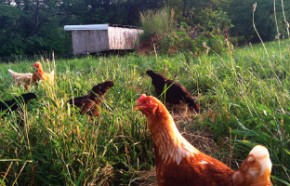Chicken keepers: Loving and eating animals

On a sunny winter day I visited the Academy for Global Citizenship, a public charter school on the southwest side of Chicago. The school emphasizes sustainability and experiential education, which includes having the students feed and water the school yard chickens, clean their coop, and collect their eggs. As I approached the coop, a half dozen kindergartners crowded around to introduce me to Buttercup, Daisy, and Puddles. Like the students, the school’s resident hens were a diverse trio, one gold-speckled brown, one glistening iridescent black, and one fluffy white. But all had the glittering eyes and brilliant red combs of healthy hens, and they clucked conversationally with each other, as contented hens do.
The children chattered away alongside the hens, comfortable with them yet respectful of their space—neither cuddling them as if they were pets nor keeping a wary distance as they would with wild animals. When recess was over I followed the children as they scampered to line up at the school door. I had come to join them for their afternoon class, a review of everything they had learned in their unit on chickens.
Having grown up in the fourth of five generations of a central Illinois farm family, I have a more than passing familiarity with chickens. Some of my earliest memories are of gathering still-warm eggs from the nesting boxes in my grandparents’ chicken coop. But these days I’ve become interested in urban chicken keeping—and in the notion of “keepers” in general.




